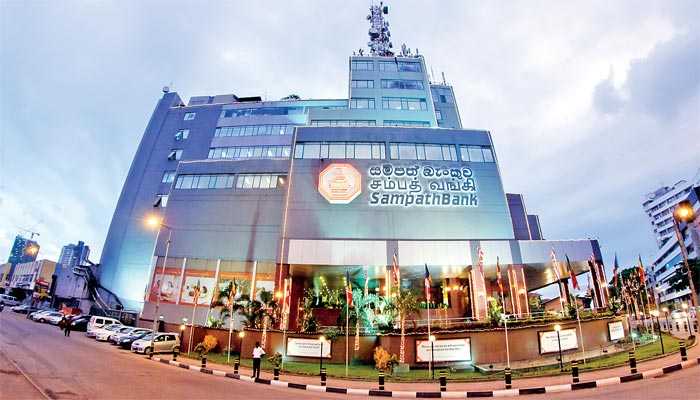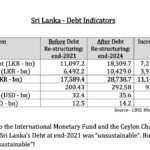Sampath Bank PLC demonstrated a robust financial performance for the fiscal year 2023, as indicated in the annual report. The bank’s total operating income reached Rs 91.0 billion, primarily consisting of net interest income of Rs 72.3 billion and net fee and commission income of Rs 18.9 billion. A significant achievement for the bank was the substantial reduction in collective impairment charges, which decreased by 67% from Rs 54.3 billion in 2022 to Rs 18.1 billion in 2023. This reduction was largely due to stringent risk management measures and improving economic conditions.
Profitability
The profitability of Sampath Bank PLC can be assessed using various financial metrics provided in the annual report for December 2023. Here are some key profitability ratios and figures:
- Return on Average Equity (ROAE) (after tax): The ROAE improved to 12.65% as of 31st December 2023, up from 10.95% at the end of the year 2022. This indicates an increase in the efficiency with which the bank is using shareholders’ equity to generate profits.
- Return on Assets (ROA) (before tax): The ROA stood at 2.12% as of 31st December 2023, compared to 1.16% reported for 2022. This suggests that the bank has become more effective at generating earnings from its asset base before taxes.
- Net Interest Margin (NIM): The NIM is a measure of the difference between the interest income generated by the bank and the amount of interest paid out to lenders, relative to the amount of their interest-earning assets. For the year 2023, the NIM figures are not explicitly provided in the context, but they are a critical component of a bank’s profitability.
- Growth in Profit: The bank experienced a growth in profit of over 30.50% in 2023, which is a substantial increase compared to the previous year’s growth of 5.43%.
- Earnings Per Share (EPS): The EPS for Sampath Bank PLC was Rs 14.62, which is an increase from the previous year’s figure of Rs 11.20, reflecting higher profitability on a per-share basis.
- Price Earnings Ratio (P/E): The P/E ratio was 4.82 times, which gives an indication of the market’s expectations of the bank’s future earnings and how much investors are willing to pay for each rupee of earnings.
- Net Asset Value (NAV) per Share: The NAV per share as of December 2023 was Rs 126.10, up from Rs 107.77 in the previous year, indicating an increase in the intrinsic value of the shares.
These figures suggest that Sampath Bank PLC has had a strong year in terms of profitability, with improvements in key metrics such as ROAE, ROA, and EPS. The bank’s ability to grow its profits and increase shareholder value is a positive sign for investors and stakeholders.
This Report is compiled by LankaBIZ (GPT) – Sri Lanka’s First ever AI Assistant for Stock Market and Research. Click below link to ask questions about any listed company in Sri Lanka.
www.lankabizz.net
Capital Adequacy and Liquidity
Based on the provided context from the Sampath Bank PLC Annual Report for December 2023, the following Capital Adequacy ratios can be identified:
- Impairment Charge as a Percentage of Total Operating Income: 17.1%
- This ratio is calculated by dividing the impairment charge by the total operating income. It provides insight into the bank’s credit risk and how much of its income is being set aside for potential loan losses.
- Capital Adequacy Ratios:
- Total Capital Ratio (Tier I + Tier II): 19.56%
- This ratio measures the bank’s capital strength and its ability to withstand financial distress. It is a key indicator of the bank’s financial stability and is closely monitored by regulators.
- Leverage Ratio: 6.39%
- The leverage ratio is an indicator of the bank’s leverage level, comparing its core capital to its total assets. It provides a measure of the bank’s ability to sustain losses and is a regulatory requirement.
- Impaired Loans (Stage 3) Ratio: 5.87%
- This ratio indicates the proportion of loans that are considered impaired or in default, which is a critical measure of the bank’s asset quality.
These ratios provide a snapshot of Sampath Bank PLC’s financial health and performance. It is important to compare these ratios with those of previous years and with industry benchmarks to get a comprehensive understanding of the bank’s position in the market.
Share Price and Performance
The share performance of Sampath Bank PLC can be evaluated by looking at various indicators such as the number of shares traded, the value of shares traded, and the share price movement over time. Based on the context provided, here are some key points regarding the share performance of Sampath Bank PLC:
- Number of Shares Traded: The number of shares traded in 2023 was 308,275,126, which is a significant increase from the 116,309,634 shares traded in 2022. This indicates higher trading activity in the bank’s shares.
- Value of Shares Traded: The value of shares traded in 2023 was Rs 18,312.82 million, which is also an increase compared to Rs 4,812.84 million in 2022. This suggests that not only were more shares traded, but the total value of these transactions was also higher.
- Share Price Movement: The context does not provide specific information about the share price movement throughout the year 2023. However, the share price can be influenced by various factors, including the bank’s financial performance, market conditions, and investor sentiment.
- Share Turnover: The average daily turnover in 2023 was Rs 75.36 million, which is higher than the Rs 20.66 million in 2022. This reflects a more active market for Sampath Bank’s shares.
- The dividend yield was 7.23%, with a dividend of රු.5.85 per share.
- The Ex-Dividend Date was set for April 1, 2024.
- The stock’s performance over different time frames was as follows:
- 5 Day: 3.19%
- 1 Month: 6.45%
- 3 Month: 15.08%
- Year-To-Date (YTD): 14.75%
- 1 Year: 58.63%
Looking ahead, Sampath Bank is prepared to navigate the challenges of the present and is optimistic about the future. The bank anticipates a period of transformation and growth for Sri Lanka and is set to play a pivotal role in this journey. The bank’s commitment to reporting excellence and transparency is evident in its efforts to enhance the scope and scale of its reporting disclosures, aligning with globally accepted best practices.
The bank’s future development is discussed in various sections of the annual report, including the Chairman’s Message, Managing Director’s Review, and Management Discussion and Analysis. Sampath Bank is focused on adapting to rapidly changing customer needs amidst challenging market conditions to maximize value for all stakeholders.
In terms of strategy, Sampath Bank plans to explore viable opportunities to expand its government securities portfolio, with an emphasis on intensifying secondary market trading. The bank also intends to explore potential investment opportunities overseas in the coming years. With the expectation of economic stability in Sri Lanka by 2024, Sampath Bank is positioning itself to focus on recoveries, with a key priority being the strengthening of the recovery process through digital technology, including Artificial Intelligence (AI), machine learning, and automation.
Overall, Sampath Bank PLC’s financial performance in 2023 has been strong, and the bank is strategically preparing for future growth and opportunities, while continuing to enhance its risk management and digital capabilities.















